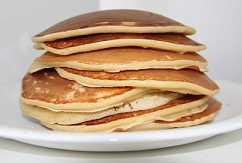|
The Feel-Good Guide to Sports, Travel, Shopping & Entertainment
|
| Main | Sports Events | Holidays & Observances | Pop Culture | Shopping | Travel |
|
Main
It's time to pig out on pancakes! Shrove Tuesday: The Pancake Fest
As far back as 1000 AD, "to shrive" meant to hear confessions. (Trivia note: the term survives today in the expression "short shrift" or giving little attention to anyone's explanations or excuses.) Shrove Tuesday also marked the beginning of the 40-day Lenten fasting period when the faithful were forbidden to consume meat, butter, eggs or milk. However, if a family had a store of these foods they would certainly spoil by the time the fast ended on Easter Sunday. What to do? Use up the milk, butter and eggs no later than Shrove Tuesday. And so, with the addition of a little flour, the solution quickly presented itself in... pancakes. Today, the Shrove Tuesday pancake tradition lives on in Western Europe, the United States, Canada and Australia. It is most associated with the UK, where it is simply known as Pancake Day with a traditional recipe that looks to all the world more like a French crepe rather than the 'mile-high' stack so popular on National Pancake Day in America:
In Sweden, Fat Tuesday translates to Fettisdagen, and in Lithuania it's Uzgavens. Meanwhile, traditional celebrations take place in Poland a week before Ash Wednesday -- on a Thursday -- and so it's Fat Thursday or Tlusty Czwartek. also see -> Pancake Recipes for Shrove Tuesday | What Mardi Gras Celebrates
|
 Shrove
Tuesday gets its name from the ritual of shriving, when the faithful
confessed their sins to the local priest and recieved forgiveness
before the Lenten season began.
Shrove
Tuesday gets its name from the ritual of shriving, when the faithful
confessed their sins to the local priest and recieved forgiveness
before the Lenten season began. 